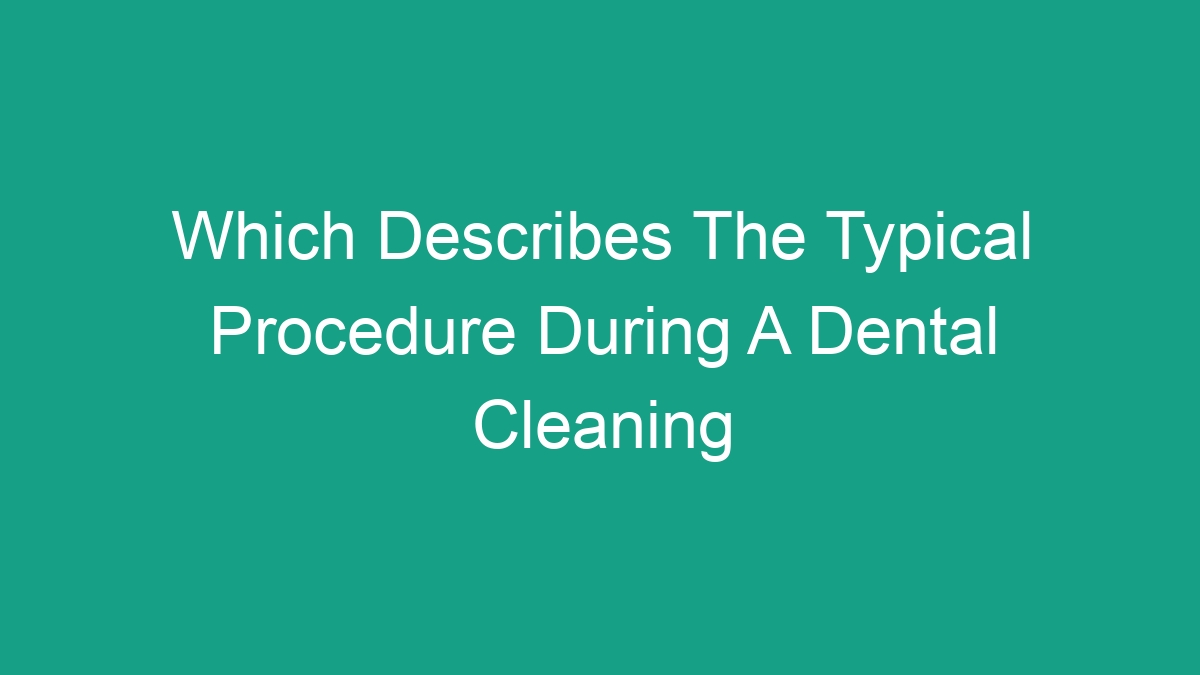
Introduction
A dental cleaning, also known as a dental prophylaxis, is an essential part of maintaining good oral health. It is recommended to have a dental cleaning twice a year to remove plaque and tartar buildup that cannot be removed by regular brushing and flossing. During a dental cleaning, a dental hygienist will perform a series of procedures to ensure your teeth and gums are healthy and clean. In this article, we will describe the typical procedure during a dental cleaning in detail, so you know what to expect next time you visit your dentist.
1. Examination and Assessment
The first step in a dental cleaning procedure is a thorough examination and assessment of your oral health. The dental hygienist will start by reviewing your medical history and discussing any concerns or changes you may have with your oral health. They will then perform a visual examination of your teeth and gums, looking for any signs of decay, gum disease, or other oral health issues. If necessary, they may also take X-rays to get a more comprehensive view of your oral health.
Key Point: The examination and assessment are important to identify any underlying dental issues and to develop a personalized plan for your dental cleaning.
2. Plaque and Tartar Removal
Once the examination is complete, the dental hygienist will begin the process of removing plaque and tartar buildup from your teeth. They will use a small mirror and a scaler to gently scrape away the plaque and tartar from the surfaces of your teeth, especially in hard-to-reach areas. This process may cause some discomfort or sensitivity, particularly if there is a significant amount of buildup, but it is essential for maintaining good oral health.
Key Point: The removal of plaque and tartar is crucial for preventing gum disease and tooth decay.
3. Professional Teeth Cleaning
After the plaque and tartar have been removed, the dental hygienist will proceed to clean your teeth using a high-powered electric toothbrush and gritty toothpaste. This special toothpaste has a slightly gritty texture that helps to polish the teeth and remove any remaining plaque or stains. The dental hygienist will also floss between your teeth to ensure that all debris is removed. This professional teeth cleaning leaves your mouth feeling fresh and smooth.
Key Point: Professional teeth cleaning not only removes plaque and tartar but also leaves your teeth looking and feeling cleaner and brighter.
4. Fluoride Treatment
Some dental cleanings may include a fluoride treatment, especially for patients who are at a higher risk of tooth decay. Fluoride is a mineral that helps to strengthen the enamel of your teeth, making them more resistant to decay. The fluoride treatment is usually applied as a gel, foam, or varnish that is brushed onto your teeth or placed in a tray that you bite down on for a few minutes. The fluoride treatment is quick and painless and provides added protection for your teeth.
Key Point: Fluoride treatment can help to prevent cavities and strengthen your teeth.
5. Oral Hygiene Education
As part of the dental cleaning procedure, the dental hygienist will take the time to educate you on proper oral hygiene practices. They may provide tips on effective brushing and flossing techniques, as well as recommendations for oral care products that may benefit your specific needs. They may also discuss the importance of a healthy diet and lifestyle choices that can impact your oral health. This education is essential for maintaining good oral hygiene between dental visits.
Key Point: Oral hygiene education empowers patients to take better care of their oral health and prevent future dental problems.
6. Follow-Up Care and Recommendations
At the end of your dental cleaning, the dental hygienist will discuss any follow-up care recommendations and schedule your next appointment. If there are any areas of concern or further treatment needed, they will communicate this to your dentist for further evaluation. They may also provide recommendations for specific dental products or treatments that can benefit your oral health. It is important to follow any post-cleaning care instructions to maintain the results of your dental cleaning.
Key Point: Follow-up care and recommendations ensure that you continue to maintain good oral health between dental visits.
Conclusion
In conclusion, a dental cleaning is a crucial part of maintaining good oral health and preventing dental problems. The typical procedure during a dental cleaning involves a thorough examination, plaque and tartar removal, professional teeth cleaning, fluoride treatment, oral hygiene education, and follow-up care recommendations. By understanding what to expect during a dental cleaning, you can feel more comfortable and confident in maintaining your oral health. It is essential to schedule regular dental cleanings and follow good oral hygiene practices to keep your smile healthy and bright.



